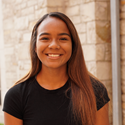MMC Professor Keeps It Old School For Photography Class
March 8, 2018
Mount Marty College (MMC) art professor David Kahle has a fondness for doing things the old-fashioned way – including how to take photos.
For 30 years, Kahle’s photography class has used 35 millimeter (mm) cameras and developed photographs in a dark room using dacthal and stop-bath chemicals.
These kinds of cameras were used more frequently when the class was first created. But even in this digital age, he has continued to have students work with these cameras simply because he likes them.
With 35 mm cameras, a photographer can control their own F-stops and shutter speeds, he added.
"As far as the relationship with light, the individual can construct contrasting values to represent different aesthetics," he said.
His appreciation of the 35 mm came from photojournalist Larry Burrows, who is known for his work during the Vietnam War. One particular photo series Kahle admires involves Vietnamese girl Nguyen Thi Tròn receiving a prosthetic limb after her leg was shot off by U.S. forces.
His favorite photo, depicting the young girl smiling as she walked for the first time with her new leg, has inspired him to not only take good photos, but also to use his artist’s eye to help people, he said.
"I teach (the students) how photography relates to other fields," he said, noting that photography in the medical world includes CAT scans and MRIs.
Once a week, students in the class present their photos based on what the project was assigned for that week, which includes photos with landscapes, selective focuses and stop actions.
"Students have the chance to study depths of field and how it works with technical equipment, maximizing efficiency and resolution," Kahle said. "The more a person can create their own composition, the more a person can learn to see in association with their cognitive skills, the more they’re going to be able to inspire and create."
All of the photos published in the class come out as black-and-white prints.
"When dealing with black and white (photos), you are looking at a scale tone where, through the use of the technology we have on hand, are able to manipulate and control the contrasting light values in order to create imagery that’s not only legible, but (also) hopefully beneficial towards aesthetics and individuality."
In addition to teaching the student about art and photography, it also gives them a chance to get outdoors, Kahle said.
Read the rest of this story on the Yankton P&D webpage.







